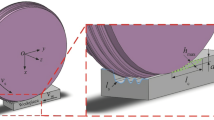Abstract
Regular precision-shaped abrasive grains are preferred to irregular grits due to their superior performance regarding uniform polishing. Three-dimensional modelling of abrasive disc’s topography is essential to understand the material removal rate and surface roughness estimations through finite element based numerical simulations. Topography modelling of one such precision (prism)-shaped grain abrasive disc is carried out in this work through stochastic studies. The abrasive discs are scanned using laser profilometer, and high-frequency noise is filtered out using spectral analysis. Spatial parameters such as autocorrelation length and texture aspect ratio are considered for the topology mapping. Based on the statistical information from the measured grit sizes #60 and #120, such as peak protrusion grain height, spatial distributions, the topography is simulated. The analysis reveals that the peak height and spatial distribution follow a normal distribution. Unlike irregularly shaped grains where the orientations of the grains are neglected, the height variations in the precision-shaped grains in coated abrasive discs are mainly caused by random orientations of the grains. So, iterations are carried out for orientation in the three (mutually perpendicular) axes of the grain till the required statistical parameters are achieved. Surface fitting is performed for the distributed grains and the 3D-surface parameters of the simulated coated abrasive topography match well with the actual discs.
Similar content being viewed by others
References
Wang G, Zhou X, Yang X, Zhou H, Chen G (2015) Material removal profile for large mould polishing with coated abrasives. Int J Adv Manuf Technol 80(1–4):625–635. https://doi.org/10.1007/s00170-014-6378-2
Fan C, Zhao J, Zhang L, Wong YS, Hong GS, Zhou W (2014) Modeling and analysis of the material removal profile for free abrasive polishing with sub-aperture pad. J Mater Process Technol 214(2):285–294
Wang G, Wang Y, Xu Z (2009) Modeling and analysis of the material removal depth for stone polishing. J Mater Process Technol 209(5):2453–2463. https://doi.org/10.1016/j.jmatprotec.2008.05.041
Cao Y, Guan J, Li B, Chen X, Yang J, Gan C (2013) Modeling and simulation of grinding surface topography considering wheel vibration. Int J Adv Manuf Technol 66(5):937–945. https://doi.org/10.1007/s00170-012-4378-7
Doman DA, Warkentin A, Bauer R (2006) A survey of recent grinding wheel topography models. Int J Mach Tool Manu 46(3–4):343–352. https://doi.org/10.1016/j.ijmachtools.2005.05.013
Koshy P, Jain V, Lal G (1997) Stochastic simulation approach to modelling diamond wheel topography. Int J Mach Tool Manu 37(6):751–761
Chen X, Rowe WB (1996) Analysis and simulation of the grinding process. Part I: generation of the grinding wheel surface. Int J Mach Tool Manu 36(8):871–882
Liu P, Lin B, Yan S, Li Y, Wang B (2016) Numerical simulation and experimental validation of fixed abrasive grinding pad topography. Int J Adv Manuf Technol 83(5–8):1253–1264
Hegeman JBJ-W (2000) Fundamentals of grinding: surface conditions of ground materials. University of Groningen, Groningen
Feng Q, Wang Q, Ren CZ (2011) Three-dimensional simulation of wheel topography. Key Eng Mater 487:149–154
Woodin CT (2014) Effects of dressing parameters on grinding wheel surface topography, PhD thesis. PhD thesis, Georgia Institute of Technology, USA
Wang W, Li J, Fan W, Song X, Wang L (2017) Characteristic quantitative evaluation and stochastic modeling of surface topography for zirconia alumina abrasive belt. Int J Adv Manuf Technol 89(9):3059–3069. https://doi.org/10.1007/s00170-016-9242-8
Anderson D, Warkentin A, Bauer R (2012) Comparison of spherical and truncated cone geometries for single abrasive-grain cutting. J Mater Process Technol 212(9):1946–1953. https://doi.org/10.1016/j.jmatprotec.2012.04.021
Zhi S, Li J, Zarembski AM (2016) Predictive modeling of the rail grinding process using a distributed cutting grain approach. Proc Inst Mech Eng F J Rail 230(6):1540–1560. https://doi.org/10.1177/0954409715605139
Chakrabarti S, Paul S (2008) Numerical modelling of surface topography in superabrasive grinding. Int J Adv Manuf Technol 39(1):29–38
Yan L, Rong YM, Jiang F, Zhou ZX (2011) Three-dimension surface characterization of grinding wheel using white light interferometer. Int J Adv Manuf Technol 55(1):133–141. https://doi.org/10.1007/s00170-010-3054-z
Blunt L, Ebdon S (1996) The application of three-dimensional surface measurement techniques to characterizing grinding wheel topography. Int J Mach Tool Manu 36(11):1207–1226
Butler DL, Blunt LA, See BK, Webster JA, Stout KJ (2002) The characterisation of grinding wheels using 3D surface measurement techniques. J Mater Process Technol 127(2):234–237. https://doi.org/10.1016/S0924-0136(02)00148-6
Nguyen AT, Butler DL (2008) Correlation of grinding wheel topography and grinding performance: a study from a viewpoint of three-dimensional surface characterisation. J Mater Process Technol 208(1):14–23. https://doi.org/10.1016/j.jmatprotec.2007.12.128
Mainsah E, Greenwood JA, Chetwynd DG (2001) Metrology and properties of engineering surfaces. Springer US, Boston. https://doi.org/10.1007/978-1-4757-3369-3
Aurich JC, Herzenstiel P, Sudermann H, Magg T (2008) High-performance dry grinding using a grinding wheel with a defined grain pattern. CIRP J Manuf 57(1):357–362. https://doi.org/10.1016/j.cirp.2008.03.093
Li X, Wolf S, Zhi G, Rong YK (2014) The modelling and experimental verification of the grinding wheel topographical properties based on the ‘through-the-process’ method. Int J Adv Manuf Technol 70(1–4):649–659
Ding W, Linke B, Zhu Y, Li Z, Fu Y, Su H, Xu J (2017) Review on monolayer CBN superabrasive wheels for grinding metallic materials. Chin J Aeronaut 30(1):109–134. https://doi.org/10.1016/j.cja.2016.07.003
Kanatani K (1990) Representation of 3D rotations. In: Group-theoretical methods in image understanding. Springer Berlin Heidelberg, Berlin. pp 197–235. doi:https://doi.org/10.1007/978-3-642-61275-6_6
MathWorks I (2002) Curve fitting toolbox: for use with MATLAB®: user’s guide. MathWorks
Sandwell DT (1987) Biharmonic spline interpolation of GEOS-3 and SEASAT altimeter data. Geophys Res Lett 14(2):139–142. https://doi.org/10.1029/GL014i002p00139
Waikar RA, Guo YB (2008) A comprehensive characterization of 3D surface topography induced by hard turning versus grinding. J Mater Process Technol 197(1):189–199. https://doi.org/10.1016/j.jmatprotec.2007.05.054
Grzesik W, Rech J, Żak K (2015) Characterization of surface textures generated on hardened steel parts in high-precision machining operations. Int J Adv Manuf Technol 78(9):2049–2056. https://doi.org/10.1007/s00170-015-6800-4
Acknowledgements
First author Adhithya Plato thanks Nanyang Technological University (NTU) Singapore and A*STAR Institute Advanced Remanufacturing Technology Centre (ARTC), Singapore, for the financial support in the form of graduate assistantship. The authors thank Dr. Takashi Sato of ARTC for many useful discussions on this work.
Author information
Authors and Affiliations
Corresponding author
Rights and permissions
About this article
Cite this article
Arunachalam, A.P.S., Idapalapati, S. Three-dimensional topography modelling of regular prismatic grain coated abrasive discs. Int J Adv Manuf Technol 96, 3521–3532 (2018). https://doi.org/10.1007/s00170-018-1731-5
Received:
Accepted:
Published:
Issue Date:
DOI: https://doi.org/10.1007/s00170-018-1731-5



